
Secotioid fungi are an intermediate growth form between mushroom-like hymenomycetes and closed bag-shaped gasteromycetes, where an evolutionary process of gasteromycetation has started but not run to completion. Secotioid fungi may or may not have opening caps, but in any case they often lack the vertical geotropic orientation of the hymenophore needed to allow the spores to be dispersed by wind, and the basidiospores are not forcibly discharged or otherwise prevented from being dispersed —note—some mycologists do not consider a species to be secotioid unless it has lost ballistospory.

The Strophariaceae are a family of fungi in the order Agaricales. Under an older classification, the family covered 18 genera and 1316 species. The species of Strophariaceae have red-brown to dark brown spore prints, while the spores themselves are smooth and have an apical germ pore. These agarics are also characterized by having a cutis-type pileipellis. Ecologically, all species in this group are saprotrophs, growing on various kinds of decaying organic matter. The family was circumscribed in 1946 by mycologists Rolf Singer and Alexander H. Smith.
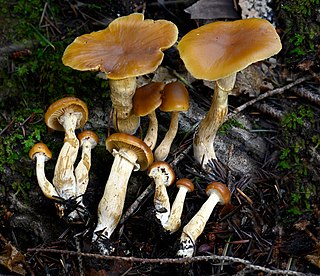
Galerina marginata, known colloquially as funeral bell, deadly skullcap, autumn skullcap or deadly galerina, is a species of extremely poisonous mushroom-forming fungus in the family Hymenogastraceae of the order Agaricales. It contains the same deadly amatoxins found in the death cap. Ingestion in toxic amounts causes severe liver damage with vomiting, diarrhea, hypothermia, and eventual death if not treated rapidly. About ten poisonings have been attributed to the species now grouped as G. marginata over the last century.

The genus Stropharia is a group of medium to large agarics with a distinct membranous ring on the stipe. Well-known members of this genus include the edible Stropharia rugosoannulata and the blue-green verdigris agarics. Stropharia are not generally regarded as good to eat and there are doubts over the edibility of several species. However the species Stropharia rugosoannulata is regarded as prized and delicious when young, and is now the premier mushroom for outdoor bed culture by mycophiles in temperate climates.

Orson Knapp Miller Jr. was an American mycologist. He published numerous papers in mycology and was responsible for the naming of many taxa, as well as being one of the authors erecting the genus Chroogomphus. He described Omphalotus olivascens, several species of Amanita, and the ghoul fungus Hebeloma aminophilum.
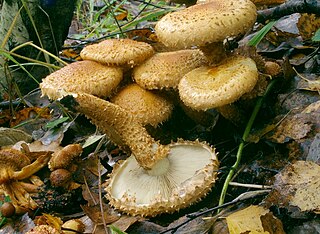
Pholiota is a genus of small to medium-sized, fleshy mushrooms in the family Strophariaceae. They are saprobes that typically live on wood. The genus has a widespread distribution, especially in temperate regions, and contains about 150 species.
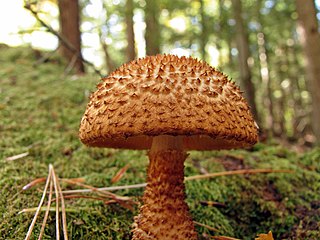
Leucopholiota decorosa is a species of fungus in the mushroom family Tricholomataceae. Commonly known as the decorated pholiota, it is distinguished by its fruit body which is covered with pointed brown, curved scales on the cap and stem, and by its white gills. Found in the eastern United States, France, and Pakistan, it is saprobic, growing on the decaying wood of hardwood trees. L. decorosa was first described by American mycologist Charles Horton Peck as Agaricus decorosus in 1873, and the species has been transferred to several genera in its history, including Tricholoma, Tricholomopsis, Armillaria, and Floccularia. Three American mycologists considered the species unique enough to warrant its own genus, and transferred it into the new genus Leucopholiota in a 1996 publication. Lookalike species with similar colors and scaly fruit bodies include Pholiota squarrosoides, Phaeomarasmius erinaceellus, and Leucopholiota lignicola. L. decorosa is considered an edible mushroom.

Pholiota flammans, commonly known as the yellow pholiota, the flaming Pholiota, or the flame scalecap, is a basidiomycete agaric mushroom of the genus Pholiota. Its fruit body is golden-yellow in color throughout, while its cap and stem are covered in sharp scales. As it is a saprobic fungus, the fruit bodies typically appear in clusters on the stumps of dead coniferous trees. P. flammans is distributed throughout Europe, North America, and Asia in boreal and temperate regions. Its edibility has not been clarified.

Pholiota squarrosa, commonly known as the shaggy scalycap, the shaggy Pholiota, or the scaly Pholiota, is a species of mushroom in the family Strophariaceae. Common in North America and Europe, it is often an opportunistic parasite, and has a wide range of hosts among deciduous trees, although it can also infect conifers. It can also live as a saprobe, deriving nutrients from decomposing wood. The mushroom is typically found growing in clusters at the base of trees and stumps. Both the cap and the stem are covered in small, pointed scales that are pointed downward and backward. The crowded gills are yellowish, then later rust-brown. The mushroom has an odor that, depending on the author, has been described as resembling garlic, lemon, radish, onion, or skunk. It has a strong taste, resembling radishes. Though edible to some, it may be toxic, especially if consumed in combination with alcohol. The mushroom contains unique chemicals thought to help it infect plants by neutralizing defensive responses employed by them. The very similar P. squarrosoides differs in having a paler cap that is sticky between the scales, and smaller spores.
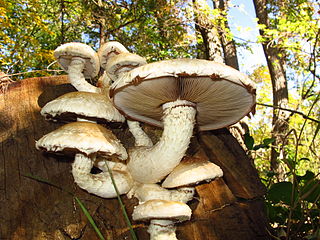
Hemipholiota is a genus of agaric fungi in the order Agaricales. It was originally proposed by Rolf Singer in 1962 as a subgenus of Pholiota to contain species with absent or sparse pleurocystidia and absent chrysocystidia. Henri Romagnesi raised it to generic status in 1980, but this naming was invalid as it did not meet the requirements of the International Code of Nomenclature for algae, fungi, and plants. Marcel Bon published the genus validly in 1986.
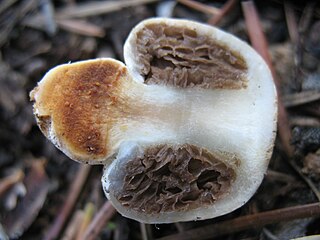
Nivatogastrium is a genus of secotioid fungi in the family Strophariaceae. The genus has contained four species found in North America and New Zealand, but the type species, Nivatogastrium nubigenum, is now considered to be a gasteroid species of Pholiota, and was transferred to that genus in 2014.
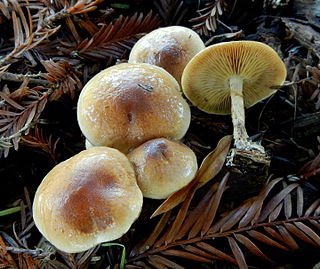
Pholiota iterata is a species of agaric fungus in the family Strophariaceae. Found in North America, it was first described formally by Alexander H. Smith and Lexemuel Ray Hesler in 1969.

Pholiota nubigena, commonly known as the gastroid pholiota or the bubble gum fungus, is a species of secotioid fungus in the family Strophariaceae. It is found in mountainous areas of the western United States, where it grows on rotting conifer wood, often fir logs. It fruits in spring, often under snow, and early summer toward the end of the snowmelt period in high mountain forests. Fruit bodies appear similar to unopened mushrooms, measuring 1–4 centimetres tall with 1–2.4 cm diameter caps that are whitish to brownish. They have a short but distinct whitish stipe that extend through the internal spore mass (gleba) of the fruit body into the cap. The gleba consists of irregular chambers made of contorted gills that are brownish in color. A whitish, cottony partial veil is present in young specimens, but it often disappears in age and does not leave a ring on the stipe.

Meottomyces is a small genus of relatively nondescript, fleshy, brown mushrooms related to Tubaria. In older classifications it had been included in Pholiota, Phaeogalera, or Hemipholiota. Modern molecular evidence suggested recognition of a separate genus when sequences of a collection first identified as Pholiota oedipus, now reclassified in Meottomyces, revealed a unique branch. Subsequently, that species was studied by Holec and later as Phaeogalera oedipus was shown to be distinct from Tubaria but not the type of Phaeogalera itself. Additional phylogenetic support was provided by Gitte Petersen and others, who clearly showed a separation from Phaeogalera. The genus was erected by Vizzini, for two species and two varieties, all former members of Pholiota. Vizzini treated the name Pholiota oedipus as a misapplied name, but this was contested by Legon, who provided detailed notes on the types and ecology of the type species.
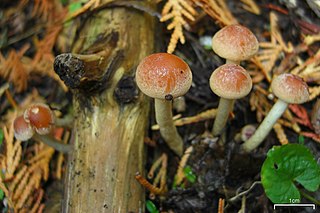
Pholiota astragalina is a species of fungus in the family Strophariaceae. It was first described scientifically in 1821 by Elias Magnus Fries as a species of Agaricus. Rolf Singer transferred it to the genus Pholiota in 1951. The fruitbodies of the fungus have pinkish-orange caps measuring 2–5.5 cm in diameter. The flesh is orange, blackening in age, with a bitter taste. They produce a reddish-brown spore print, causing it to be placed in its genus rather than Hypholoma, which it resembles. The spores are oval to elliptical, smooth with thin walls, and measure 5–7 by 4–4.5 µm. In North America, the fungus is found in the United States and Canada. In Europe, it has been recorded from France, Sweden, and Switzerland. Its mushrooms usually grow singly or in small clusters, sometimes on conifer logs.

Pholiota gummosa, commonly known as the sticky scalycap, is a common species of mushroom-forming fungus in the family Strophariaceae. It is found in Europe and North America, where it grows as a saprotroph on the rotting wood of deciduous trees, including trunks and roots. It can also grow on wood buried near the surface, making it seem as if it is fruiting in grass.

Pholiota squarrosoides is a species of mushroom in the family Strophariaceae. It is similar to the species Pholiota squarrosa. There are differing accounts on whether the mushroom is edible.
















